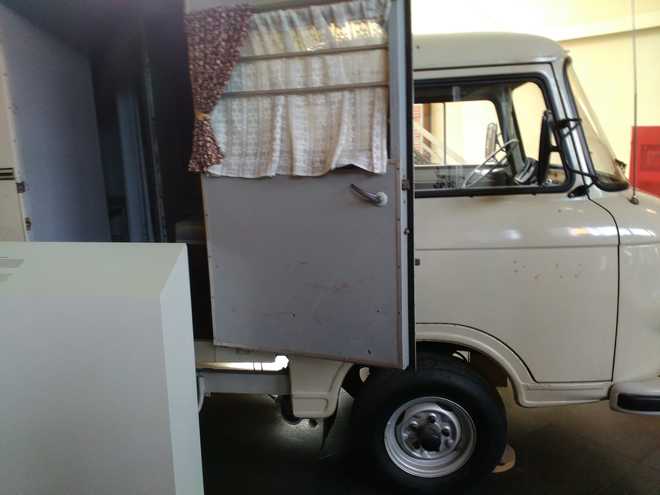
Typical Stasi surveillance and abduction van
Salil Desai
Twenty five years after the re-unification, wounds of the infamous Berlin wall and the communist regime of the erstwhile GDR are still raw, but if one senses that Germany is finally at peace with itself after a turbulent 20th century, then it is because the Germans have chosen to shine a light on appalling, inconvenient truths through memorials like the Stasi Museum and Checkpoint Charlie Museum, which hide or justify nothing.
The Stasi Museum lays bare the monstrous working of the much-feared East German Secret Police agency, Stasi. Located in the headquarters of former Stasi chief, Erich Mielke, the museum shows just how warped an ideologically-obsessed state can be, in controlling its citizens. The Stasi was a hydra-headed organisation, tasked with identifying non-conforming citizens, putting them under surveillance and neutralising them in whatever way necessary. The aim was to prevent these potential ‘enemies of the state’from infecting other citizens by spreading disaffection through democratic ideas that did not match the communist worldview.
Through original displays — documents, objects, pictures, audio-video recordings, the museum outlines how the system worked with ruthless efficiency. It started with identifying trouble-makers and misfits — anyone who fell short of being the ideal socialist citizen. Even a wrong, punk-style haircut or the smallest streak of rebelliousness could land one into the category of undesirables. Musicians, artists, writers and other creative people almost always fell into this category as did just about anyone else who demanded civil or political rights, thought and acted independently, and did things that the state frowned upon. They became life-long targets of elaborate surveillance, harassment, intimidation, hounding and finally even death.
The Stasi subverted the society by turning people into informers, including family and friends. It also shows how bias and prejudice can damage and destroy a society beyond measure. The official terms that the Stasi used to describe its targets is chilling — betrayer, vermin, foreign to socialism, dissenter, hostile-decadent, harmful, deviant.
The Stasi Museum deconstructs the various processes, methods and technology used to shadow and break targets. The privacy of many was blatantly invaded for years with all kinds of gadgets. Others were harmed, coerced, blackmailed, tortured, even killed. Against those whom the state couldn't dig up dirt, everything was done to make their lives hell. Victim testimonies reveal vividly what they had to go through. A respected priest, who spoke out against state excesses, had his reputation destroyed by a whisper campaign about his wife's non-existent affairs, initiated by Stasi. A young doctor was driven to near-insanity and finally suicide by the devastating psychological tool of simply entering her house daily and re-arranging things. Houses were bugged with such sophistication, that some surveillance gadgets were discovered years after the Stasi folded up.
The museum also gives interesting insights into the propaganda machinery used to discredit targets, constantly create an atmosphere threats to the state from internal enemies and justify all actions of the Stasi as the pursuit of national interest. The recruitment and indoctrination of Stasi cadre is also an eye-opener as to how dangerous the concoction of ideology and policing is. Recordings of Stasi personnel show that these officers were absolute believers in the foul, totalitarian ideology of the state, not law and justice. What chance could a target have then, once he was branded as 'harmful'? The museum documents roles and pinpoints responsibilities of all Stasi top brass. There is also a secret recording of Erich Mielke, in which he chillingly endorses the practice of summary executions, as humanitarian.
Complementing the Stasi Museum is the Checkpoint Charlie Museum, located near the famous border post between East and West Berlin till German reunification, which showcases stories of those who still managed to defy the GDR regime and escaped to freedom. It celebrates their spirit, daring and creativity.
The museum is the rich repository of original artefacts, contributed by escapees and others, that bring alive the resistance and thirst for freedom displayed by East Germans against repression. Among the many extraordinary devices used to flee East Germany are a mini-submarine, a canoe, a hot-air balloon, a homemade hang-glider and even a loudspeaker box, which an American musician used to tow his East German wife to freedom, while she crouched inside in a foetal position. Other escape exhibits are no less innovative — the bonnet of an Isetta car, a chair-lift, a cement mixer trolley, a baby suitcase.
The museum also displays information panels, media stations and exhibits on successful mass escape bids through tunnels, historic demonstrations and protests by East Germans, artistic representations of the Berlin Wall, and the many security mechanisms deployed by the GDR along with bloody crackdowns in preventing its citizens from escaping.
Indeed, for those of us who were old enough to witness live the historic footage of the fall of the Berlin Wall in 1989 will be better able to fathom the raw sentiments of the Germans, after a visit to these two museums.



























